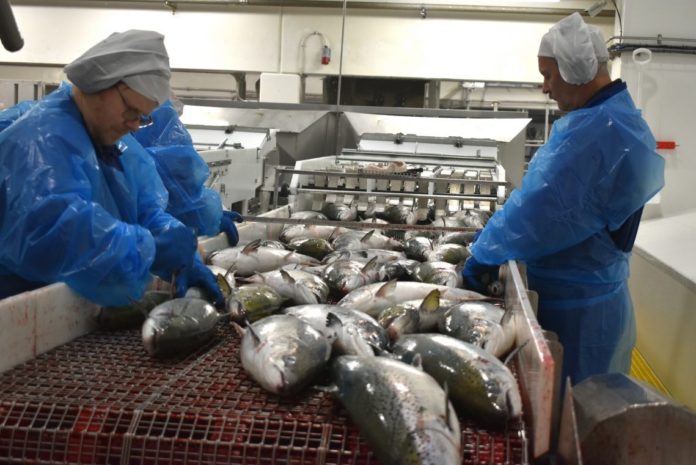The market is flooded with fish, particularly those with low average weights.
“There is far too much fish. You struggle to find customers. And transportation is a nightmare. If you haven’t booked a truck, it will cost you NOK 80,000 ($7,600/€6,800) to drive one from Northern Norway to Oslo,” says a buyer to SalmonBusiness.
He refers to the following prices, for salmon delivered next week:
- 2-3 kg: NOK 40 ($3.80/€3.40)
- 3-4 kg: NOK 60-61 ($5.70/€5.10)
- 4-5 kg: NOK 63 ($6.00/€5.40)
- 5-6 kg: NOK 65-66 ($6.20-6.30/€5.50-5.60)
“The customers are just sitting there deciding the price – whether they want it or not. It’s full everywhere. It’s not easy,” he says.
Record Export
Last week, 38,909 tonnes of salmon were exported, converted to round weight, according to the Norwegian Seafood Council. There has never been more salmon exported from Norway in a single week.
“Yes, there is a lot of fish. And a high pace in what we’re doing. The pressure is being felt everywhere, both in transport and at the terminals. It’s difficult,” says another buyer.
“It’s clear the price is under pressure. Down toward NOK 60 ($5.70/€5.10) for 3-4 kg. We haven’t seen prices drop to the NOK 50s yet,” he adds.
However, another exporter has seen prices in the NOK 50s.
“I’d say NOK 59-60 ($5.60-5.70/€5.00-5.10) for 3-4 kg, NOK 62-63 ($5.90-6.00/€5.30-5.40) for 4-5 kg, NOK 65-66 ($6.20-6.30/€5.50-5.60) for 5-6 kg, and 2-3 kg has performed really poorly. That’s in the low NOK 40s, between NOK 40-43 ($3.80-4.10/€3.40-3.60),” he says.
“There are enormous quantities. For 2-3 and 3-4 kg, there’s just so much of that size. And now we are seeing that Poland doesn’t want fish, and the Netherlands doesn’t want fish – from these processing markets. They’re struggling to keep up.”
“There is an unbelievable amount of fish, and the logistics are a nightmare. It’s tough. Simply put,” he says, exasperated.
Buffering Stocks
A farmer confirms falling prices but not as low as those mentioned by the exporters.
“We haven’t sold anything to Poland and Lithuania, but elsewhere it’s NOK 64 ($6.10/€5.40) for 3-4 kg, NOK 66-67 ($6.30-6.40/€5.60-5.70) for 4-5 kg, and around NOK 70 ($6.70/€5.95) for 5-6 kg. The 2-3 kg has been lower, but it’s in the mid-NOK 40s ($3.80-4.10/€3.40-3.60). So it’s a NOK 20 drop from 3-4 kg, and I can’t recall seeing that before. There’s a lot of small fish – and a lot of fish overall. It’s the highest export volume ever, according to the latest export statistics,” he says.
“The activity happening in the market… considering how much is being exported, in the mid-NOK 60s ($6.00/€5.40), indicates that there’s a lot of activity not necessarily going directly to consumption. Freezing and the like – as happens every autumn. But it seems even more intense now,” he continues.
“And buyers see that when there’s a lot of small fish, it eats into the future. So it’s even more important to build that stockpile and that buffer – because the spike could go even higher.”
SalmonBusiness gathers spot prices for salmon every Friday after lunch, tracking fish to be delivered the following week. This process involves contacting multiple entities in the value chain, including farmers, exporters, and importers. At least five independent sources are consulted, though they may not always be publicly disclosed.


